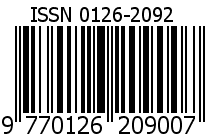Pengaruh Pemberian Mesenchymal Stem Cell Wharton's Jelly Terhadap Aktivitas Enzim Katalase pada Tikus Wistar Model Hiperglikemia
Abstract
Objective: To determine the effect of Wharton's Jelly (MSC-WJ) mesenchymal stem cells on the activity of the catalase enzyme in hyperglycemic Wistar rats. Methods: This study used 21 male Wistar rats aged 2-3 months with a body weight of 200-300 grams according to the inclusion and exclusion criteria. Mice were divided into 3 groups: negative control (K-), positive control (K+), and treatment (P). Group K- was only given food and drink without being given treatment. The K+ group was injected intraperitoneally with alloxan at a dose of 100 mg/kg BW so that the rats became hyperglycemic. Group P was given an alloxan injection and left for a week, then given MSC-WJ 3x106 cells through the tail vein and left for four weeks. After four weeks, all groups had their blood taken to examine the catalase enzyme. Result: Mean of catalase activity enzyme in the K-, K+, and P groups were 4.22 ± 0.27 units/mg, 2.39 ± 0.19 units/mg, and 3.93 ± 0.45 units /mg, respectively. Conclusion: This shows that the administration of mesenchymal stem cells Wharton's Jelly (MSC-WJ) has an effect on increasing the serum catalase enzyme activity of Wistar rats with hyperglycemia models.
Keywords
Full Text:
PDFReferences
Magliano DJ, Boyko EJ, Balkau B, Barengo N, Barr E, Basit A, et al. IDF diabetes atlas 10th edition. 2021. Available from: www.diabetesatlas.org
Volpe CMO, Villar-Delfino PH, Dos Anjos PMF, Nogueira-Machado JA. Cellular death, reactive oxygen species (ROS) and diabetic complications review-Article. Cell Death Dis. 2018 Feb 1;9(2).
World Health Organization. Noncommunicable Diseases. 2021 Apr 13.
Badan Penelitian dan Pengembangan Kesehatan Kementerian Kesehatan Republik Indonesia. Hasil utama riskesdas 2018. 2018.
Sukarma W. Laporan nasional riskesdas 2018. Badan Penelitian dan Pengembangan Kesehatan Kementerian Kesehatan Republik Indonesia. 2018.
Suarsana IN, Utama IH, Kardena IM. Immunohistochemical expression of insulin and glucagon, superoxide dismutase and catalase activity in pancreas in hyperglycaemia condition. Asian J Biochem. 2016;11(4–5):177–85.
Rains JL, Jain SK. Oxidative stress, insulin signaling, and diabetes. Free Radical Biology and Medicine. 2011;50:567–75.
Zhang P, Li T, Wu X, Nice EC, Huang C, Zhang Y. Oxidative stress and diabetes: antioxidative strategies. Frontiers of Medicine. Higher Education Press Limited Company. 2020;14:583–600.
Saxena S, Jamil K. Oxidative stress and expression level of catalase, glutathione s tranferase enzyme in type 2 diabetes patients. Int J Sci Eng Res. 2014;5(8):1127–31.
Zainuri M, Wanandi SI, Litbangkes B, Ri K. Aktivitas spesifik manganese superoxide dismutase (mnsod) dan katalase pada hati tikus yang diinduksi hipoksia sistemik: hubungannya dengan kerusakan oksidatif. Media Litbang Kesehatan. 2012;22.
Zuraida, Yerizel E, Anas E. Pengaruh pemberian ekstrak rosella (hibiscus sabdariffa linn) terhadap kadar malondialdehid dan aktivitas katalase tikus yang terpapar karbon tetraklorida. J Kesehat Andalas. 2015;4(3):795–802.
Rifai L, Saleh FA. Conventional and alternative mesenchymal stem cell therapies for the treatment of diabetes. In: Advances in Experimental Medicine and Biology. Springer.2021:97–106.
Pan G, Mu Y, Hou L, Liu J. Examining the therapeutic potential of various stem cell sources for differentiation into insulin-producing cells to treat diabetes. Ann Endocrinol (Paris). 2019 Feb 1;80(1):47–53.
Kamal MM, Kassem DH. Therapeutic potential of wharton’s jelly mesenchymal stem cells for diabetes: achievements and challenges. Frontiers in Cell and Developmental Biology. Frontiers Media S.A. 2020;8.
Hu J, Wang Y, Gong H, Yu C, Guo C, Wang F, et al. Long term effect and safety of wharton’s jelly-derived mesenchymal stem cells on type 2 diabetes. Exp Ther Med. 2016 Sep 1;12(3):1857–66.
Burra P, Arcidiacono D, Bizzaro D, Chioato T, Di Liddo R, Banerjee A, et al. Systemic administration of a novel human umbilical cord mesenchymal stem cells population accelerates the resolution of acute liver injury. BMC Gastroenterol. 2012;12(1):1.
Ighodaro OM, Adeosun AM, Akinloye OA. Alloxan-induced diabetes, a common model for evaluating the glycemic-control potential of therapeutic compounds and plants extracts in experimental studies. Med. 2017;53(6):365–74.
Al-Awar A, Kupai K, Veszelka M, Szucs G, Attieh Z, Murlasits Z, et al. Experimental diabetes mellitus in different animal models. J Diabetes Res. 2016.
Ighodaro OM, Adeosun AM, Asejeje FO, Soetan GO, Kassim OO. Time course effects of 5,5-dihydroxyl pyrimidine-2,4,6-trione (alloxan) as a diabetogenic agent in animal model. Alexandria J Med. 2018 Dec 1;54(4):705–10.
Wang H, Qiu X, Ni P, Qiu X, Lin X, Wu W, et al. Immunological characteristics of human umbilical cord mesenchymal stem cells and the therapeutic effects of their transplantion on hyperglycemia in diabetic rats. Int J Mol Med. 2014;33(2):263–70.
El-Tantawy WH, Haleem ENA Al. Therapeutic effects of stem cell on hyperglycemia, hyperlipidemia, and oxidative stress in alloxan-treated rats. Mol Cell Biochem. 2014;391(1–2):193–200.





















